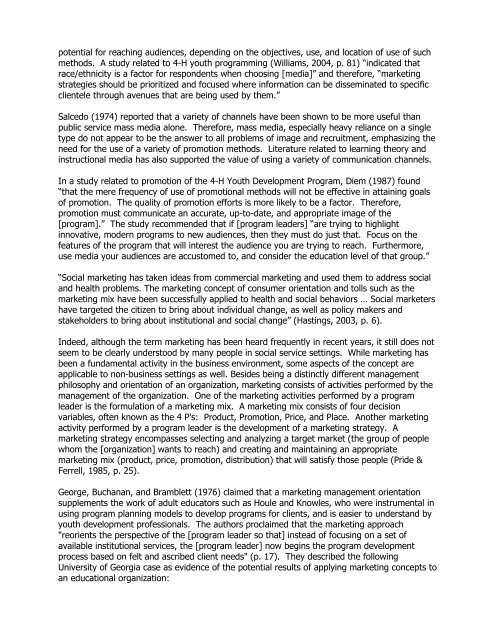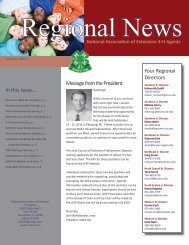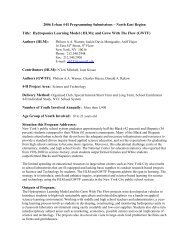potential for reaching audiences, depending on the objectives, use, and location <strong>of</strong> use <strong>of</strong> suchmethods. A study related to 4-H youth programming (Williams, 2004, p. 81) “indicated thatrace/ethnicity is a factor for respondents when choosing [media]” and therefore, “marketingstrategies should be prioritized and focused where information can be disseminated to specificclientele through avenues that are being used by them.”Salcedo (1974) reported that a variety <strong>of</strong> channels have been shown to be more useful thanpublic service mass media alone. Therefore, mass media, especially heavy reliance on a singletype do not appear to be the answer to all problems <strong>of</strong> image and recruitment, emphasizing theneed for the use <strong>of</strong> a variety <strong>of</strong> promotion methods. Literature related to learning theory andinstructional media has also supported the value <strong>of</strong> using a variety <strong>of</strong> communication channels.In a study related to promotion <strong>of</strong> the 4-H Youth Development Program, Diem (1987) found“that the mere frequency <strong>of</strong> use <strong>of</strong> promotional methods will not be effective in attaining goals<strong>of</strong> promotion. The quality <strong>of</strong> promotion efforts is more likely to be a factor. Therefore,promotion must communicate an accurate, up-to-date, and appropriate image <strong>of</strong> the[program].” The study recommended that if [program leaders] “are trying to highlightinnovative, modern programs to new audiences, then they must do just that. Focus on thefeatures <strong>of</strong> the program that will interest the audience you are trying to reach. Furthermore,use media your audiences are accustomed to, and consider the education level <strong>of</strong> that group.”“Social marketing has taken ideas from commercial marketing and used them to address socialand health problems. The marketing concept <strong>of</strong> consumer orientation and tolls such as themarketing mix have been successfully applied to health and social behaviors … Social marketershave targeted the citizen to bring about individual change, as well as policy makers andstakeholders to bring about institutional and social change” (Hastings, 2003, p. 6).Indeed, although the term marketing has been heard frequently in recent years, it still does notseem to be clearly understood by many people in social service settings. While marketing hasbeen a fundamental activity in the business environment, some aspects <strong>of</strong> the concept areapplicable to non-business settings as well. Besides being a distinctly different managementphilosophy and orientation <strong>of</strong> an organization, marketing consists <strong>of</strong> activities performed by themanagement <strong>of</strong> the organization. One <strong>of</strong> the marketing activities performed by a programleader is the formulation <strong>of</strong> a marketing mix. A marketing mix consists <strong>of</strong> four decisionvariables, <strong>of</strong>ten known as the 4 P's: Product, Promotion, Price, and Place. Another marketingactivity performed by a program leader is the development <strong>of</strong> a marketing strategy. Amarketing strategy encompasses selecting and analyzing a target market (the group <strong>of</strong> peoplewhom the [organization] wants to reach) and creating and maintaining an appropriatemarketing mix (product, price, promotion, distribution) that will satisfy those people (Pride &Ferrell, 1985, p. 25).George, Buchanan, and Bramblett (1976) claimed that a marketing management orientationsupplements the work <strong>of</strong> adult educators such as Houle and Knowles, who were instrumental inusing program planning models to develop programs for clients, and is easier to understand byyouth development pr<strong>of</strong>essionals. The authors proclaimed that the marketing approach"reorients the perspective <strong>of</strong> the [program leader so that] instead <strong>of</strong> focusing on a set <strong>of</strong>available institutional services, the [program leader] now begins the program developmentprocess based on felt and ascribed client needs" (p. 17). They described the followingUniversity <strong>of</strong> Georgia case as evidence <strong>of</strong> the potential results <strong>of</strong> applying marketing concepts toan educational organization:
In applying these marketing techniques, the service activities <strong>of</strong> the university haveincreased. The average annual increase in the number <strong>of</strong> programs held oncampus has been 20% for the last 3 years, while the number <strong>of</strong> <strong>of</strong>f-campusprograms and projects conducted in the same period has tripled. This expansionhas occurred without additions to the resource base. In addition, the pre- andpost-program evaluations have revealed that the quality <strong>of</strong> service now beingreceived by the clientele groups has risen sharply (p. 16).George, et al. concluded by stating that the “program will ultimately fail unless marketinginformation is collected and used to develop marketing plans that effectively serve the … unit'spublics" (p. 19).Needs assessment is a valuable marketing function. For example, a nationwide needsassessment was conducted (Diem, 2007) to ensure that plans to expand the Clemson UniversityYouth Development Leadership (YDL) degree program would meet the needs <strong>of</strong> organizationsrelated to the youth development pr<strong>of</strong>ession. In the process <strong>of</strong> conducting it, a variety <strong>of</strong>findings proved beneficial for determining similarities and differences among youth developmentorganizations as well as implications for the types <strong>of</strong> degrees that would be most valuable forpr<strong>of</strong>essionals in contemporary youth development organizations.Whitlock and Hamilton (2003) provided perspective on multiple approaches to the role <strong>of</strong> youthsurveys in understanding youth needs and improving communities as contexts for youthdevelopment. <strong>National</strong> Longitudinal Surveys <strong>of</strong> Youth (2002) conducted by the U.S. Department<strong>of</strong> Labor Bureau <strong>of</strong> Labor Statistics have served as an important tool for economists, sociologists,and other researchers. Other surveys (Diem, 1990; Diem, 1991; Diem, 1992b/c; Diem, 1994;Diem, & Rothenburger, 2001; Warner, Christenson, Dillman, & Salant, 1996) have looked at theneeds, interests, and perceptions <strong>of</strong> youth, adult volunteers, and the public regardingeducational events and programs.In recent years, an important application <strong>of</strong> marketing concepts has been to demonstrate andcommunicate program impact to stakeholders. Impact … is the positive difference we make inpeople’s lives as a result <strong>of</strong> programs we conduct. These programs may include teaching,published curriculum, volunteer training, or applied research and, may or may not involve thepublic directly while they are being delivered. Yet the results programs achieve must ultimatelychange people’s attitudes or behavior, or benefit society in other ways (Diem, 1997). “Provingprogram impact is important to:• justify the investment <strong>of</strong> time and effort, as well as the dedication <strong>of</strong> public and privatefunds.• earn and build pr<strong>of</strong>essional, organizational, and political credibility and support.• satisfy the requirements <strong>of</strong> political bodies and funding agencies.• yield tangible results that serve as a basis for scholarly publications, as well as awardsand recognition.• determine, to what degree, that participants achieve intended results” (Diem, 2003).
- Page 2 and 3: Winter 2008Volume 3 Number 3Editor
- Page 5: Examining the Potential Unintended
- Page 8 and 9: centered, multidisciplinary approac
- Page 10 and 11: Volume 3, Number 3, Winter 2008Arti
- Page 12 and 13: fostering skill learning and positi
- Page 14 and 15: Table 1Participation in out-of-scho
- Page 16 and 17: ResultsOur analyses were conducted
- Page 18 and 19: watching TV, playing video games or
- Page 20 and 21: Accordingly, this research augments
- Page 22 and 23: Dotterer, A.M., McHale, S.M., & Cro
- Page 24 and 25: A Descriptive View of the 4-H Club
- Page 26 and 27: In this paper, the results of a cro
- Page 28 and 29: section is a set of statements that
- Page 30 and 31: Table 3Experience in the 4-H clubNo
- Page 32 and 33: significantly higher than Caucasian
- Page 34 and 35: p
- Page 36 and 37: This study focused only on the 4-H
- Page 38 and 39: Theokas, C., Lerner, J.V., Phelps,
- Page 40 and 41: Volume 3, Number 3, Winter 2008Arti
- Page 44 and 45: Putting Marketing Concepts into Pra
- Page 46 and 47: 2. Find out what others think about
- Page 48 and 49: Diem, K.G. (1994). What do youth li
- Page 50 and 51: Promoting Supportive Relationships
- Page 52 and 53: focused on youth-adult relationship
- Page 54 and 55: Conversely, more modern educational
- Page 56 and 57: perhaps most importantly, the effic
- Page 58 and 59: Organized youth programs, when stru
- Page 60 and 61: likely to internalize the positive
- Page 62 and 63: Ellis, J.M., & Caldwell, L.L. (2005
- Page 64 and 65: Schweinle, A., Meyer, D.K., & Turne
- Page 66 and 67: Volume 3, Number 3, Winter 2008Arti
- Page 68 and 69: This study uses the “5 Cs” mode
- Page 70 and 71: ResultsIn this analysis 48 codes we
- Page 72 and 73: Table 3Inductive Codes Classified b
- Page 74 and 75: CompetenceCompetence in organized s
- Page 76 and 77: ecause of him (the coach)…. You d
- Page 78 and 79: practices and competitions, the gir
- Page 80 and 81: Eccles, J.S., & Gootmann, J.A. (Eds
- Page 82 and 83: Smoll, F.L., & Smith, R.E. (2002).
- Page 84 and 85: Volume 3, Number 3, Winter 2008Arti
- Page 86 and 87: The present work builds upon that o
- Page 88 and 89: MethodSample and Data CollectionAs
- Page 90 and 91: (scores ranging from 0 to 8) and a
- Page 92 and 93:
Table 2Paired Sample T-tests Compar
- Page 94 and 95:
Hypotheses 5 and 6 were tested by c
- Page 96 and 97:
De Coverly Veale, D.M.W. (1987). Ex
- Page 98 and 99:
Story, M., Neumark-Sztainer, D., Sh
- Page 100 and 101:
Volume 3, Number 3, Winter 2008Arti
- Page 102 and 103:
Cronbach’s Alpha Score For Youth
- Page 104 and 105:
12 to 18 years old. Fourteen of the
- Page 106 and 107:
Therefore, there was a mixed relati
- Page 108 and 109:
Youth respondents identified two ob
- Page 110 and 111:
are developed through working in a
- Page 112 and 113:
Seevers, B.S., & Dormody, T.J. (199
- Page 114 and 115:
Volume 3, Number 3, Winter 2008Arti
- Page 116 and 117:
With the many opportunities that yo
- Page 118 and 119:
meaningfully reduced involving dedu
- Page 120 and 121:
StaffingXTime/Schedule X X XTrainin
- Page 122 and 123:
“Involving adults that will allow
- Page 124 and 125:
“They can't drive or do not have
- Page 126 and 127:
page in understanding why youth voi
- Page 128 and 129:
Parker, L. (1999). If all youth ser
- Page 130 and 131:
Volume 3, Number 3, Winter 2008Arti
- Page 132 and 133:
However, the literature is mixed in
- Page 134 and 135:
group was the quality of the progra
- Page 136 and 137:
Table 1Reasons for Non-Attendance:
- Page 138 and 139:
easons given was six. Sixty-three p
- Page 140 and 141:
The non-family-related activities t
- Page 142 and 143:
“Catch ‘Em Being Good:”An Ext
- Page 144 and 145:
In 2001, the WVUES received a schoo
- Page 146 and 147:
to leverage the resources of the co
- Page 148 and 149:
4. Most primary behavior incidents
- Page 150 and 151:
Recommendations for developing prog
- Page 152 and 153:
Cross-Cultural UnderstandingThrough
- Page 154 and 155:
that plague these nations such as p
- Page 156 and 157:
2003). Youth leadership training in
- Page 158 and 159:
• enable these young people to pa
- Page 160 and 161:
We believe that the USPORT program
- Page 162 and 163:
West Virginia’s Response to theRo
- Page 164 and 165:
Ensuring good oral health requires
- Page 166 and 167:
Table 1Correlations between Planner
- Page 168 and 169:
problems in this rural state…This
- Page 170 and 171:
Volume 3, Number 3, Winter 2008Arti
- Page 172 and 173:
vacuum. Determination of factors, a
- Page 174 and 175:
ReferencesBaldwin, C., & Caldwell,
- Page 176 and 177:
Volume 3, Number 3, Winter 2008Arti
- Page 178 and 179:
Purpose of StudyThe purpose of this
- Page 180 and 181:
Students in the High computer gamin
- Page 182 and 183:
Do Higher Levels of 4-H LeadershipA
- Page 184 and 185:
IntroductionEmotional Intelligence
- Page 186 and 187:
second section examined demographic
- Page 188 and 189:
a constructive manner. The group is
- Page 190 and 191:
differences in the scores for the 1
- Page 192 and 193:
Adaptability include “Reality Tes
- Page 194 and 195:
ReferencesAmerican Academy of Pedia
- Page 196 and 197:
Healthy Kids, Healthy Families:A Co
- Page 198 and 199:
and a half million U.S. youth (ages
- Page 200 and 201:
Families. In partnering counties, p
- Page 202 and 203:
Healthy Families was then offered a
- Page 204 and 205:
Kamberelis, G., & Dimitriadis, G. (
- Page 206 and 207:
Volume 3, Number 3, Winter 2008Arti
- Page 208 and 209:
Change It Up!What Girls Say About R
- Page 210:
In addition, the study summarizes t






